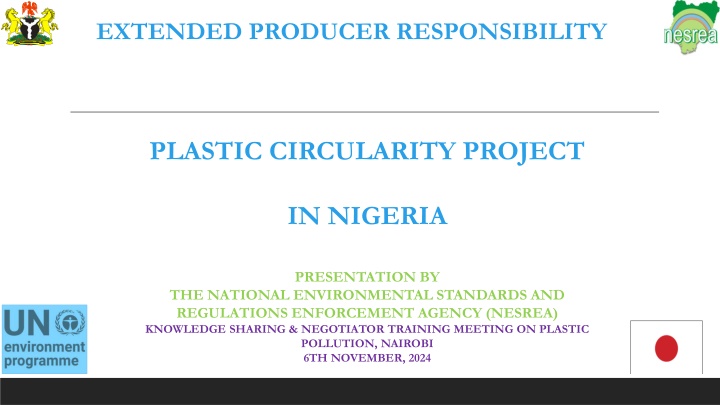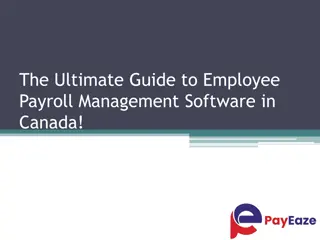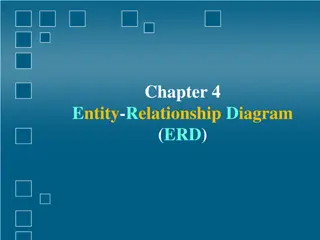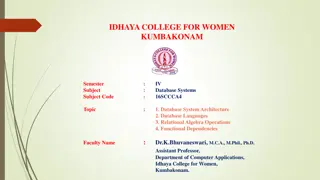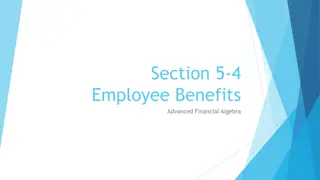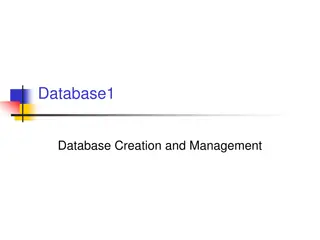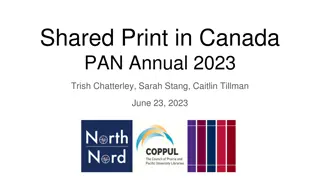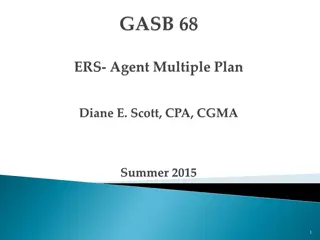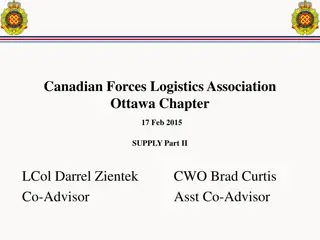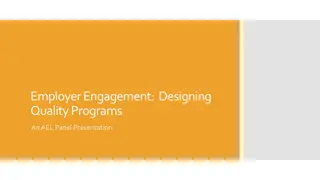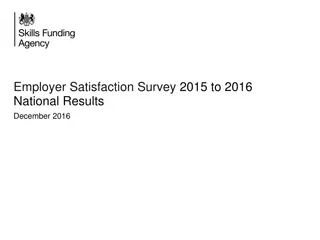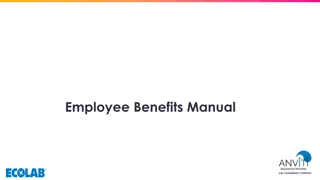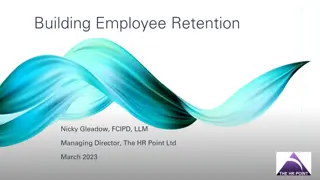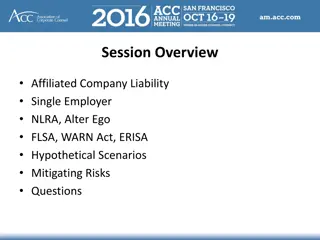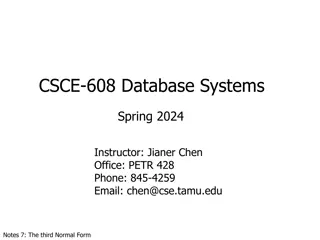Canadian Employer-Employee Dynamics Database Overview
CEEDD provides linked data between employees and employers in the Canadian labor market for cross-sectional and longitudinal analysis. It includes various component files containing individual and job-level data, offering opportunities for immigration-related research.
Download Presentation

Please find below an Image/Link to download the presentation.
The content on the website is provided AS IS for your information and personal use only. It may not be sold, licensed, or shared on other websites without obtaining consent from the author.If you encounter any issues during the download, it is possible that the publisher has removed the file from their server.
You are allowed to download the files provided on this website for personal or commercial use, subject to the condition that they are used lawfully. All files are the property of their respective owners.
The content on the website is provided AS IS for your information and personal use only. It may not be sold, licensed, or shared on other websites without obtaining consent from the author.
E N D
Presentation Transcript
EXTENDED PRODUCER RESPONSIBILITY PLASTIC CIRCULARITY PROJECT IN NIGERIA PRESENTATION BY THE NATIONAL ENVIRONMENTAL STANDARDS AND REGULATIONS ENFORCEMENT AGENCY (NESREA) KNOWLEDGE SHARING & NEGOTIATOR TRAINING MEETING ON PLASTIC POLLUTION, NAIROBI 6TH NOVEMBER, 2024
OUTLINE 1. General Introduction 2. Small Scale Funding Agreement for the Improvement of EPR in Plastic Packacging in Nigeria (Activities, Outcome) 3. Conclusion
Nigeria Population and Waste Generation Data Nigeria has a population of over 220 million people, 36 States & FCT Generates over 32 million tonnes of solid waste annually
NESREA ESTABLISMENT Arising from the dumping of toxic waste in KOKO village in 1987, The Federal Government in line with section 20 of the 1999 Constitution of the Federal Republic of Nigeria, established NESREA, a parastatal of the Federal Ministry of Environment. By the NESREA establishment Act 2007, the Federal Environmental Protection Agency Act Cap F 10 LFN 2004 has been repealed. Federal Ministry of Environme nt in 1999, The Bill for an Act establishing NESREA was passed by the National Assembly, signed into law and published in the Federal Republic of Nigeria Official Gazette No. 92. Vol. 94 of 31st July, 2007 FEPA in 1988,
MANDATE NESREA Act empowers the Agency to be responsible for enforcing all environmental laws, guidelines, policies, standards and regulations in Nigeria, as well as enforcing compliance with provisions of international agreements, protocols, conventions and treaties on the environment to which Nigeria is a signatory.
EPR IN NIGERIA Addressing growing challenges of plastics pollution mandates producers to take responsibility for the entire lifecycle of their products Reduce use of Virgin Plastics (SD) Increase rates of achieving the circular economy pillars Promote transparency Livelihood and informal sector inclusion 2014 OPERATIONAL GUIDELINES FOR THE IMPLEMENTATION OF EPR PROGRAMME DEVELOPED Sector-specific General EPR Operational guideline Voluntary system Mandatory system DRAFT NATIONAL GUIDELINES FOR THE IMPLEMENTATION OF EXTENDED PRODUCER RESPONSIBILITY (EPR) FOR (PLASTIC) PACKAGING Stakeholder Revision/ inputs /comments Enrichment/ robustness 2024 Inclusivity and compliance
Activity 1 Written inputs to the project proposal on innovative EPR, includingbut not limited to the context (including overview of EPRimplementation milestones and planning in Nigeria, existing policygaps), problem identification, theory of change, project activities,stakeholder responsibilities, budget, risk mitigation strategies. Eco-modulations fee & re-use scheme SUPPORT FROM FFEM (French PRO)
Activity 2 Improve the guidance document for the implementation of the Extended ProducerResponsibility (EPR) programme on packaging, through organizing stakeholder consultationand developing further details for the implementation guidance, including details on differentimplementation options, data collection and management, setting up of the fee structure, etc.
Activity 2 Develop Enforcement Plan of EPR Policy and Regulations in selected states inNigeria
Table of Content of the EPR Guidelines P ii Acronym list List of Figures List of Tables
Producers Responsibilities Producers are expected to take practical measures: Formation and Subscription to PRO Produce clear/colourless plastic bottle packaging. Reducing the weight of plastic used for product packaging, without lowering the recyclability of the packaging units. Using recycled material for part or all of the material used in the packaging units. Transition to rPET Using environment-friendly alternatives to plastics. Avoiding unnecessary packaging units. Avoiding plastics that are difficult to sort or recycle, such as complex plastics, certain colored plastics, etc. Placing on the market reusable packaging units, combined with mechanisms to make them effectively reused.
PRO REQUIREMENTS Application for authorization as a PRO Applicant must have the following, for authorization Letters of intent technical and financial capacity legal structure and ownership human resources and expertise PRO operating model PRO general operating model
REGISTRATION AND DECLARATION PROCESS - REGISTRY FOR PLASTIC PACKAGING
PRO requirements (contd) PRO information system Key Features of PRO Information System for Stakeholders in EPR Programme Key Features of PRO Information System for Stakeholders in EPR Programme EPR Fee mechanism The EPR Fees are calculated to cover the costs incurred by the PROs, which may include: Waste collection costs. Waste processing costs (storage, sorting, recycling, recovery), net of any recovered material value. Education and awareness expenditure incurred toward Consumers, Producers, Waste Operators and municipalities. Research and development. Information system costs. Audit costs. Reporting costs. Administration costs. Overheads.
OUTCOME Written inputs to the project proposal on innovative EPR: FFEM Project Proposal. 2025 - 2030 To Reduce plastic pollution through EPR policy with an eco- design and re-use approach Draft National Guidelines for the Implementation of EPR for Packaging (Plastic)- Validated on 18th September, 2024;
Next to do Publishing of the Guidelines Development of Enforcement Plan of EPR Policy and Regulations
Conclusion The Agency appreciates the Embassy of Japan in Nairobi for the funding support, also to UNEP for facilitating the support as well as technical inputs. Mariko Contiuous capacity development for the Agency, and stakeholders (FMENV, Academia, Producers, PROs, Retailers, Consumers, etc..) has been identified as one of the needs towards enhancing EPR implementation. Behavioural Change, improvement on swm infrastructure, political will and funding
Thank you NATIONAL ENVIRONMENTAL STANDARDS AND REGULATIONS ENFORCEMENT AGENCY (NESREA) 56 Lome Crescent, Zone 7, Wuse Abuja Nigeri www.nesrea.gov.ng ENSURING A CLEANER & HEALTHIER ENVIRONMENT FOR ALL NIGERIANS
